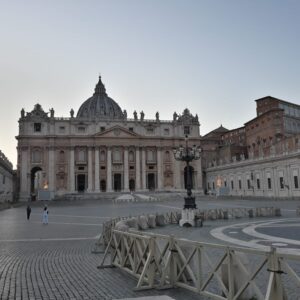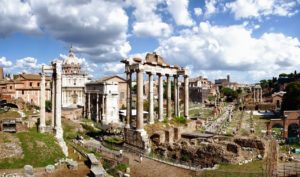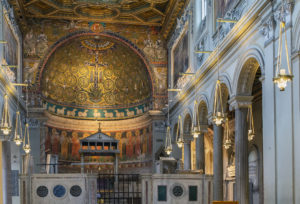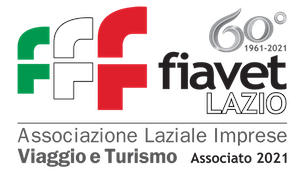Not all tourists who come to discover the treasures of Rome spend part of their time visiting EUR (acronym for Esposizione Universale di Roma), a Roman district known for its monumental and rationalist architecture located in the southern part of the capital. Lovers of this architectural style, predominant in the first half of the 20th century, should devote at least half a day to this district. Why? Let’s find out together in this article!
A Historical Note
Born as a project for the 1942 Universal Exposition – E42 – never realized due to the war, EUR has managed to transform itself into a modern hub that hosts some of Rome’s most interesting contemporary art works. Home to offices and prestigious residences, a place appreciated for shopping and trendy venues, EUR has adapted to the various epochal transformations that have affected the city, giving the district an even more contemporary allure. Large companies have moved their headquarters here: symbol of this change is the huge Eni skyscraper, which with its glass walls, still overlooks the lake from its twenty-one floors.
A Fantastic District
This is how Federico Fellini, the famous director of films such as “La Dolce Vita”, described EUR. For Fellini, this district was very suitable for those who work with images. With its architectures that seem to come out of a De Chirico painting and its metaphysical settings, EUR in the intentions of those who wanted to create this district, Benito Mussolini, was to bring Rome back to the center of the European scene and update the city on the latest trends in contemporary architecture. 100 years later, it is still difficult to evaluate the architectural impact of this vast and grand rationalist project carried out by Piacentini without being influenced by the historical events that would lead to the well-known facts that brought about World War II and the role of Mussolini’s Italy; however, one must consider the absolute cultural, artistic, and urban value of these interventions, which have given the city a district that still has no equal in the world.
Places to Visit
- The Museum of Roman Civilization and the Museum of the Early Middle Ages One of the landmarks for contemporary art in EUR is the Museum of Roman Civilization, located in Piazza Guglielmo Marconi. This museum, in addition to offering a vast collection of historical and archaeological artifacts, hosts temporary exhibitions of contemporary artists who dialogue with the ancient, creating a fascinating contrast between past and present. Next door, the Museum of the Early Middle Ages is another space that has embraced contemporary art, with installations and works that explore historical and modern themes.
- Palazzo della Civiltà Italiana The Palazzo della Civiltà Italiana, also known as the “Square Colosseum”, is one of the iconic buildings of EUR. Since 2015, this architectural monument has been the headquarters of the fashion house Fendi, which has renovated the building and opened it to the public with contemporary art exhibitions. The interior spaces of the palace regularly host exhibitions that celebrate both design and modern art, making the building a meeting point between fashion, art, and architecture.
- The Cloud by Fuksas One of the most recent and iconic interventions in the area is the Cloud by Fuksas, designed by architect Massimiliano Fuksas. This modern convention center is a futuristic structure that stands out for its bold and innovative design. In addition to hosting international events, the Cloud is also an exhibition space that welcomes contemporary art works, conferences, and performances, making it a dynamic and avant-garde cultural hub.
- The EUR Lake and Central Park The EUR Lake and the surrounding Central Park are known as places for relaxation and leisure, but also for hosting outdoor art installations. During the summer, the park comes alive with cultural events and contemporary sculpture exhibitions, transforming the area into an open-air art gallery. These events provide a platform for emerging and established artists, creating a dialogue between art and nature.
- The Congress Palace It is an extraordinary structure designed by architect Adalberto Libera in pure neoclassical style. Inside there are the Salone della Cultura, the two Kennedy and Art foyers, the Capitalis Auditorium, and the Terrace. It boasts 2,500 square meters of exhibition space. Today it hosts events and conferences.
Curiosities about EUR
- The Palazzo della Civiltà Italiana has been nicknamed the “Square Colosseum” for its structure reminiscent of the Flavian amphitheater. Its monumental architecture has inspired numerous artists and directors, becoming an icon of cinema and photography.
- The 1960 Olympics, held in Rome, allowed for the completion of the district’s work, transforming it into the financial and business hub we know today. In continuity with the initial project, and still under the direct control of Piacentini, all unfinished buildings were completed, with the relevant change of use of all buildings designed for military forces now destined for museums.
- An underground air raid shelter was wanted by Mussolini in the only building completed before the outbreak of the war. We are talking about the Palazzo degli Uffici, the pilot building designed as a model before all the others. The bunker built under this building, in reinforced concrete, measures 475 square meters with a 125 cm gap that isolates it from the rest of the structure. Equipped with a double dynamo for electricity and ventilation that can be activated by a pair of bicycles, it has several rooms with gas-tight metal doors and is designed to accommodate about 300 people. Today, the bunker is occasionally opened to the public, especially for guided tours and cultural events.
Conclusion
EUR is much more than a district of Rome; it is history, art, architecture, and contemporaneity. Whether you are a resident or a visitor, exploring art in EUR offers a unique and enriching experience, demonstrating that the eternal city continues to evolve and innovate, always maintaining a deep connection with its extraordinary history.














